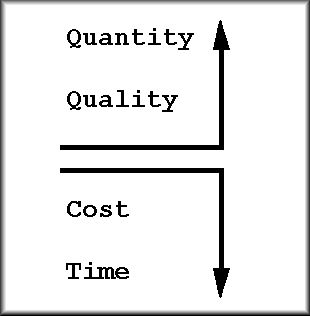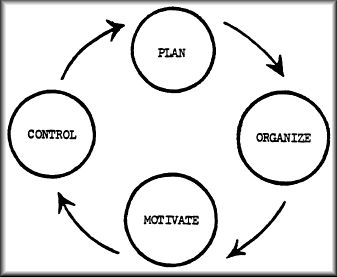Quality,
or how it is to be done
3. Cost of
doing the work
4.
Time it
will take to do the work
In any business activity, these four
factors constitute the basis for managerial control. In the accomplishment of
any plan the quantity of work, the quality of the work, the
cost of doing the work, and the time necessary for doing the work can
all be controlled. These factors apply to mental work as well as physical. It is
the function .of the manager to establish standards of quality., quantity,
time, and cost for each major work activity. Further it is his job to
find ways to increase quantity and quality while decreasing the time and cost'
of performing the work:

It is important to remember that no one of
these factors can be considered alone. You cannot demand Quantity without
weighing its effect on Quality or Cost or Time. You can't
demand lower Cost without considering the possible effect on the other
factors.
If a manager, planning a job, overlooks
these four measurable factors and their relationship, he will have no basis of
controlóno way of assuring performance in
TOP
EFFECTING CONTROL
Once standards have been established in
terms of the objectives of the plan, control may be exercised over performance.
In order to effect control, the following kinds of activities are necessary:
1. Compare performance to standard.
2. Report performance.
3. Analyze and Evaluate the results of
performance.
4. Take corrective action or stay with
original plan.
COMPARISON
is necessary in order to determine the difference between the standards and the
actual performance. This part of the control process should be done as close as
possible to the point of performance in order that deviations may be quickly
located and responsibility determined.
It is not usually sufficient just to
establish that some deviation between actual and planned performance has
occurred. Some judgment must be made concerning the significance of the observed
deviations. In order for this judgment to be made, the results of comparison
must be REPORTED
to the control authority. That is, the ' person who exercises control
authority over the performance in question must be immediately informed of the
results of comparison. In some cases the one who compares and the control
authority are the same person. In this kind of situation the comparison and
reporting steps are one and the same. In cases where standards are not definite
or tend to be intangible, comparison and reporting may come about only through
observation of performance by the control authority. The results of the
comparison will be made known to the individual/s who have authority for control
of performance.
The next step to be taken by the
control authority is to ANALYZE 'and EVALUATE the reports of comparison
to determine the nature and extent of variations. Some judgment must be formed
as to the significant variations. It is not always possible to set an absolute
standard of variation since in one situation twenty percent may not be
significant while in another a variation of one quarter of one percent may be
quite significant. Thus, the control authority must, through analysis and
evaluation of the reports of comparison, judge whether or not performance is
progressing according to plan.
TOP
In view of the judgment formed by the control authority as to
the significance of variations from planned performance, action must be
instituted in order to remove obstacles to the accomplishment of plans or to
correct unsatisfactory variations from plans. This CORRECTIVE ACTION is
planned by the control authority and put into effect by those having authority
over the actual performance. Here again, the control authority and the one who
has authority over performance may be the same person. But in many more
situations the plans for corrective action and the effecting of such plans' are
performed by different persons.
CORRECTIVE ACTION may only involve a
change in orders to the work group. In case of failure to meet a given quantity
standard, corrective action may involve motivating the work group to speedier
accomplishment. In another situation it might involve a change in the method
of performance in order to allow faster performance. Failure to meet quality
standards might be corrected by a change in process or, if this is not possible,
by changing the standard ó the plan. As a result of the analysis and
evaluation of control reports, corrective action is formulated and put into
effect to bring performance back into the planned path. Of course, if everything
is going as planned no corrective action is required and the original plan stays
in effect.
It should be remembered that control is like a feed-back. It
tells the manager exactly how the organization is doing, and gives everyone the
facts they need for future planning. Control is not the "brake", as
some people foolishly believe. Every plan, therefore, must provide for all
elements of control procedure to be a complete plan.

PRINCIPLE OF CONTROL -- Only through control can management be
certain that its planning, organization, and motivation are achieving the
desired results.
TOP